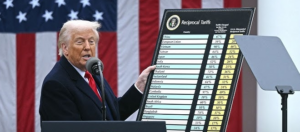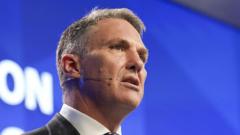The new tariff policy, enforced on April 9, 2025, aims to reshape global trade but raises concerns over economic backlash and consumer prices.
**Escalating Trade Tensions: Trump's Tariff Strategy Sparks Global Reactions**

**Escalating Trade Tensions: Trump's Tariff Strategy Sparks Global Reactions**
U.S. President Donald Trump implements significant tariffs, prioritizing economic reform and retaliatory measures against nations like China.
As of April 9, 2025, President Donald Trump has initiated a groundbreaking tariff strategy, marking a pivotal point in his administration's approach to international trade. Officially termed "Liberation Day," the new policy includes a broad 10% tariff on all imports, while implementing punitive "reciprocal" tariffs targeting countries that impose high trade barriers against American products.
China is at the forefront of Trump's tariff agenda, facing a combined total tariff rate of 54% on imports. This hefty rate integrates a newly added 34% reciprocal duty alongside an existing 20% tariff, reflecting the administration's assertion that it is responding to China's persistent protective trade behavior and intellectual property theft.
Other countries are not immune to the heightened tariff measures, as the European Union, Japan, South Korea, Vietnam, and Taiwan face increased tariffs ranging from 20% to 46%. The blanket 10% tariff came into effect on April 5, while country-specific tariffs were enforced shortly thereafter.
In defense of this aggressive approach, Trump stated, "We’re not starting a trade war. We’re ending the one they’ve been waging against us for years." However, criticisms are multiplying, with opponents warning that such tariffs could lead to inflation for U.S. consumers and potential retaliatory moves from impacted nations. China has already responded with counter-tariffs on American goods and limitations on exports of rare earth minerals crucial for U.S. industries.
The stock market has shown signs of instability, reflecting investor anxieties regarding the long-term consequences of this escalated trade conflict. Economic experts express concern that the tariffs may alter the landscape of global trade dynamics if other countries opt to follow Trump’s protective approach.
Despite the ongoing dissent, the Trump administration remains firm, asserting these tariffs signify the commencement of a larger effort to bolster domestic manufacturing, impose consequences on unfair trade partners, and reaffirm U.S. economic strength on the global stage.
China is at the forefront of Trump's tariff agenda, facing a combined total tariff rate of 54% on imports. This hefty rate integrates a newly added 34% reciprocal duty alongside an existing 20% tariff, reflecting the administration's assertion that it is responding to China's persistent protective trade behavior and intellectual property theft.
Other countries are not immune to the heightened tariff measures, as the European Union, Japan, South Korea, Vietnam, and Taiwan face increased tariffs ranging from 20% to 46%. The blanket 10% tariff came into effect on April 5, while country-specific tariffs were enforced shortly thereafter.
In defense of this aggressive approach, Trump stated, "We’re not starting a trade war. We’re ending the one they’ve been waging against us for years." However, criticisms are multiplying, with opponents warning that such tariffs could lead to inflation for U.S. consumers and potential retaliatory moves from impacted nations. China has already responded with counter-tariffs on American goods and limitations on exports of rare earth minerals crucial for U.S. industries.
The stock market has shown signs of instability, reflecting investor anxieties regarding the long-term consequences of this escalated trade conflict. Economic experts express concern that the tariffs may alter the landscape of global trade dynamics if other countries opt to follow Trump’s protective approach.
Despite the ongoing dissent, the Trump administration remains firm, asserting these tariffs signify the commencement of a larger effort to bolster domestic manufacturing, impose consequences on unfair trade partners, and reaffirm U.S. economic strength on the global stage.


















